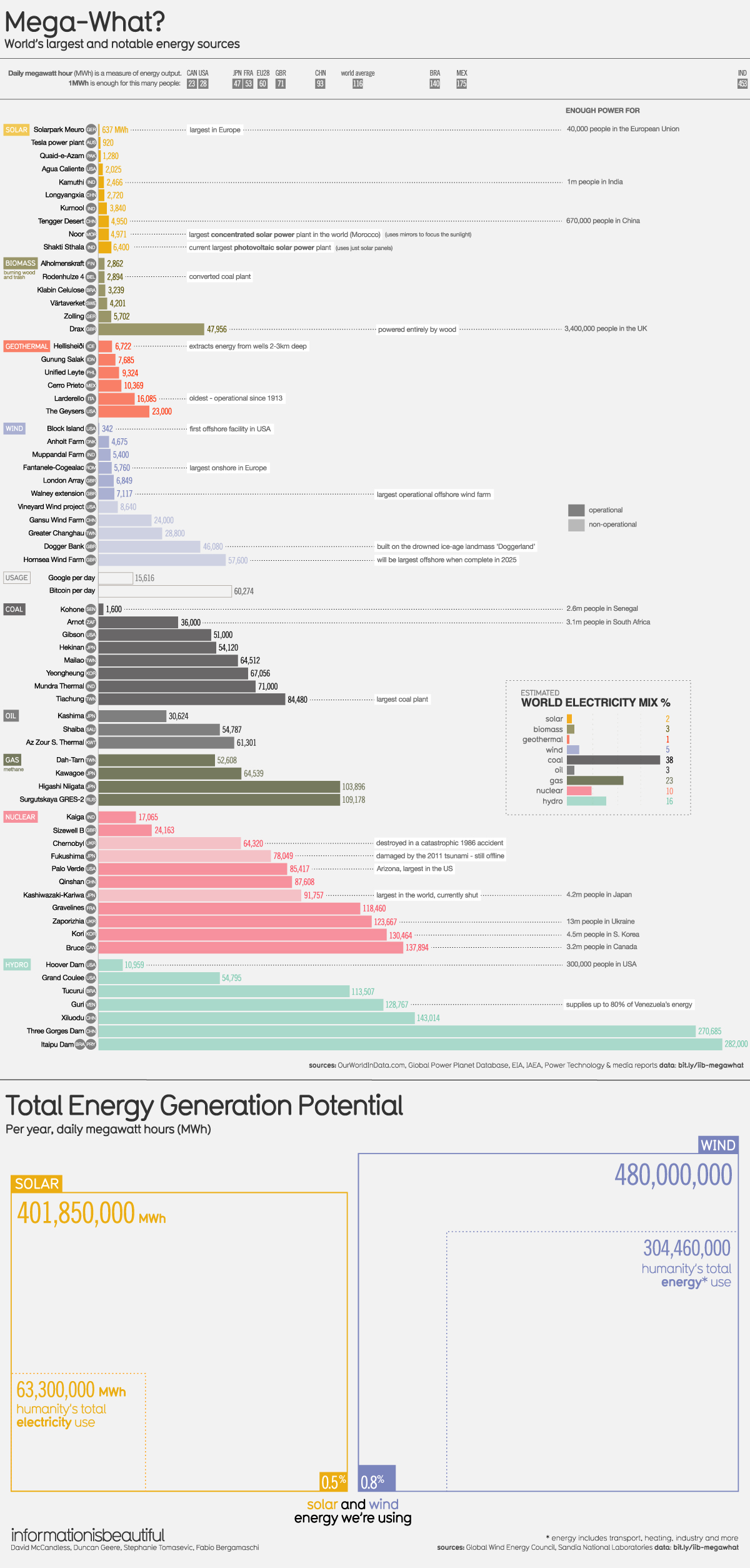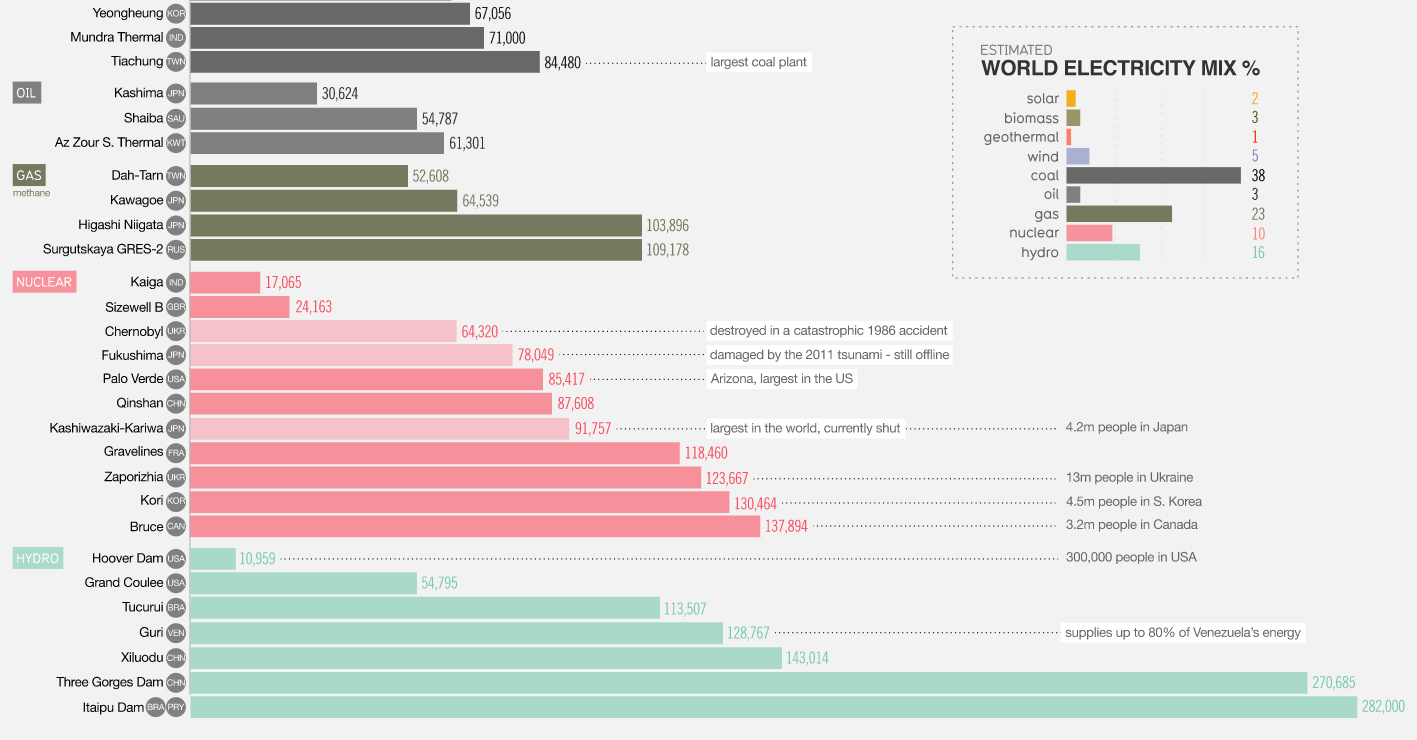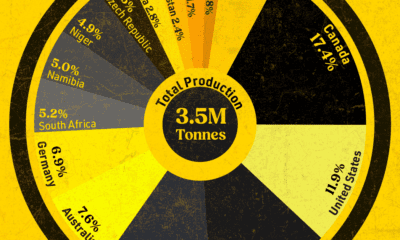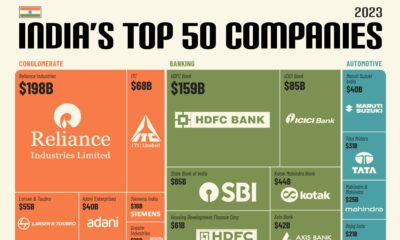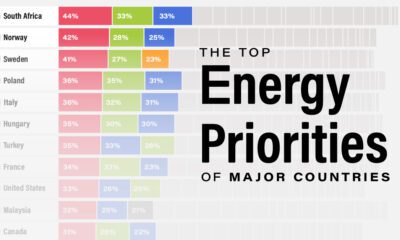Energy
Ranked: The World’s Largest Energy Sources
The World’s Largest and Most Notable Energy Sources
Every day, humans consume roughly 63,300,000 megawatt-hours (MWh) of electricity to power our homes, workplaces, and vehicles─about the same produced by over 5,700 Hoover Dams.
While present-day electricity generation is slanted heavily in favor of coal and gas on a global basis, renewable sources have started to gain ground.
Today’s graphic from Information is Beautiful lists the world’s largest energy sources and their energy outputs. These power plants are ranked using the daily megawatt-hour (MWh), the amount of energy a power source generates in a day.
Relying on Renewables
Located in the United Kingdom, Drax Power Station is the world’s largest biomass plant, powered chiefly by burning wood. Originally a coal-fired plant, Drax is expected to fully phase out coal by the year 2025.
Meanwhile, Tengger Desert Solar Park in China was the biggest solar operation until 2018, but it has since been displaced by the Shakti Sthala plant in India. The latter uses only solar panels─no mirrors─to generate energy from the sun.
Overall, solar photovoltaics have experienced the highest growth of all energy source segments, showing 31% annual growth─nearly triple the rate of wind power according to the International Energy Association (IEA).
Untapped Potential?
Currently, 27% of the world’s power comes from renewable energy sources such as solar, wind, hydro, biomass, and other similar resources.
However, according to back-of-the-envelope calculations, the potential for renewables is far beyond existing generation capacity. In fact, humans are just using 0.81% of solar’s potential generation capacity, and 0.57% of the potential from wind.
| Wind | Solar | Hydro | Geothermal | |
|---|---|---|---|---|
| Potential Energy Generation Capacity | 480,000,000 MWh | 401,850,000 MWh | 86,400,000 MWh | 48,767,123 MWh |
| Energy Generated (Current) | 3,884,983 MWh | 2,304,000 MWh | 11,465,753 MWh | 201,761 MWh |
| % of Potential Used | 0.81% | 0.57% | 13.3% | 0.41% |
Non-renewable Energy Sources
Nuclear power plants have perhaps the strongest stigma against them─largely due to international disasters such as Chernobyl and Fukushima.
However, nuclear power plants are still the most efficient energy sources, sitting at over 90% average capacity.
The largest nuclear plant (by MW) in the world, Kashiwazaki-Kariwa, is currently shut down due to damage from a 2007 earthquake, and awaiting confirmation to restart operations. As a result, the Bruce Nuclear Generating Station in Canada now holds the title of the largest operating reactor in the world. The plant currently generates about 30% of Ontario’s power.
In 2018, coal is still being used to generate roughly 38% of the world’s total electricity, followed by natural gas with a 23% share.
The Future of Energy Potential
Fittingly, the graphic also shows daily energy outputs for Google and Bitcoin usage. This data helps remind us that our online activity also consumes energy─something that will be top of mind as technology continues to advance and humans need to use more energy through our internet-enabled devices.
Understanding humanity’s need for energy is a daunting endeavor, but it’s critical to ensuring our planet has a sustainable source of energy for generations to come.
Energy
Charted: 4 Reasons Why Lithium Could Be the Next Gold Rush
Visual Capitalist has partnered with EnergyX to show why drops in prices and growing demand may make now the right time to invest in lithium.

4 Reasons Why You Should Invest in Lithium
Lithium’s importance in powering EVs makes it a linchpin of the clean energy transition and one of the world’s most precious minerals.
In this graphic, Visual Capitalist partnered with EnergyX to explore why now may be the time to invest in lithium.
1. Lithium Prices Have Dropped
One of the most critical aspects of evaluating an investment is ensuring that the asset’s value is higher than its price would indicate. Lithium is integral to powering EVs, and, prices have fallen fast over the last year:
| Date | LiOH·H₂O* | Li₂CO₃** |
|---|---|---|
| Feb 2023 | $76 | $71 |
| March 2023 | $71 | $61 |
| Apr 2023 | $43 | $33 |
| May 2023 | $43 | $33 |
| June 2023 | $47 | $45 |
| July 2023 | $44 | $40 |
| Aug 2023 | $35 | $35 |
| Sept 2023 | $28 | $27 |
| Oct 2023 | $24 | $23 |
| Nov 2023 | $21 | $21 |
| Dec 2023 | $17 | $16 |
| Jan 2024 | $14 | $15 |
| Feb 2024 | $13 | $14 |
Note: Monthly spot prices were taken as close to the 14th of each month as possible.
*Lithium hydroxide monohydrate MB-LI-0033
**Lithium carbonate MB-LI-0029
2. Lithium-Ion Battery Prices Are Also Falling
The drop in lithium prices is just one reason to invest in the metal. Increasing economies of scale, coupled with low commodity prices, have caused the cost of lithium-ion batteries to drop significantly as well.
In fact, BNEF reports that between 2013 and 2023, the price of a Li-ion battery dropped by 82%.
| Year | Price per KWh |
|---|---|
| 2023 | $139 |
| 2022 | $161 |
| 2021 | $150 |
| 2020 | $160 |
| 2019 | $183 |
| 2018 | $211 |
| 2017 | $258 |
| 2016 | $345 |
| 2015 | $448 |
| 2014 | $692 |
| 2013 | $780 |

3. EV Adoption is Sustainable
One of the best reasons to invest in lithium is that EVs, one of the main drivers behind the demand for lithium, have reached a price point similar to that of traditional vehicle.
According to the Kelly Blue Book, Tesla’s average transaction price dropped by 25% between 2022 and 2023, bringing it in line with many other major manufacturers and showing that EVs are a realistic transport option from a consumer price perspective.
| Manufacturer | September 2022 | September 2023 |
|---|---|---|
| BMW | $69,000 | $72,000 |
| Ford | $54,000 | $56,000 |
| Volkswagon | $54,000 | $56,000 |
| General Motors | $52,000 | $53,000 |
| Tesla | $68,000 | $51,000 |
4. Electricity Demand in Transport is Growing
As EVs become an accessible transport option, there’s an investment opportunity in lithium. But possibly the best reason to invest in lithium is that the IEA reports global demand for the electricity in transport could grow dramatically by 2030:
| Transport Type | 2022 | 2025 | 2030 |
|---|---|---|---|
| Buses 🚌 | 23,000 GWh | 50,000 GWh | 130,000 GWh |
| Cars 🚙 | 65,000 GWh | 200,000 GWh | 570,000 GWh |
| Trucks 🛻 | 4,000 GWh | 15,000 GWh | 94,000 GWh |
| Vans 🚐 | 6,000 GWh | 16,000 GWh | 72,000 GWh |
The Lithium Investment Opportunity
Lithium presents a potentially classic investment opportunity. Lithium and battery prices have dropped significantly, and recently, EVs have reached a price point similar to other vehicles. By 2030, the demand for clean energy, especially in transport, will grow dramatically.
With prices dropping and demand skyrocketing, now is the time to invest in lithium.
EnergyX is poised to exploit lithium demand with cutting-edge lithium extraction technology capable of extracting 300% more lithium than current processes.

-

 Lithium4 days ago
Lithium4 days agoRanked: The Top 10 EV Battery Manufacturers in 2023
Asia dominates this ranking of the world’s largest EV battery manufacturers in 2023.
-

 Energy1 week ago
Energy1 week agoThe World’s Biggest Nuclear Energy Producers
China has grown its nuclear capacity over the last decade, now ranking second on the list of top nuclear energy producers.
-

 Energy1 month ago
Energy1 month agoThe World’s Biggest Oil Producers in 2023
Just three countries accounted for 40% of global oil production last year.
-

 Energy1 month ago
Energy1 month agoHow Much Does the U.S. Depend on Russian Uranium?
Currently, Russia is the largest foreign supplier of nuclear power fuel to the U.S.
-

 Uranium2 months ago
Uranium2 months agoCharted: Global Uranium Reserves, by Country
We visualize the distribution of the world’s uranium reserves by country, with 3 countries accounting for more than half of total reserves.
-

 Energy3 months ago
Energy3 months agoVisualizing the Rise of the U.S. as Top Crude Oil Producer
Over the last decade, the United States has established itself as the world’s top producer of crude oil, surpassing Saudi Arabia and Russia.
-

 Debt1 week ago
Debt1 week agoHow Debt-to-GDP Ratios Have Changed Since 2000
-

 Markets2 weeks ago
Markets2 weeks agoRanked: The World’s Top Flight Routes, by Revenue
-

 Countries2 weeks ago
Countries2 weeks agoPopulation Projections: The World’s 6 Largest Countries in 2075
-

 Markets2 weeks ago
Markets2 weeks agoThe Top 10 States by Real GDP Growth in 2023
-

 Demographics2 weeks ago
Demographics2 weeks agoThe Smallest Gender Wage Gaps in OECD Countries
-

 United States2 weeks ago
United States2 weeks agoWhere U.S. Inflation Hit the Hardest in March 2024
-

 Green2 weeks ago
Green2 weeks agoTop Countries By Forest Growth Since 2001
-

 United States2 weeks ago
United States2 weeks agoRanked: The Largest U.S. Corporations by Number of Employees

